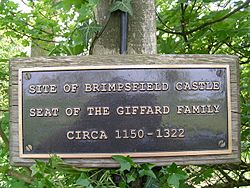Brimpsfield Castle facts for kids
Quick facts for kids Brimpsfield Castle |
|
|---|---|
| Brimpsfield, Gloucestershire | |
|
Site of Brimpsfield Castle
|
|
| Coordinates | 51°48′50″N 2°5′10″W / 51.81389°N 2.08611°W |
| Type | Motte Castle |
| Site information | |
| Open to the public |
Public footpaths cross the site |
| Official name | Brimpsfield Castle Mound |
| Designated | 17 August 1948 |
| Reference no. | 1003343 |
| Condition | Demolished, only earthworks remain |
| Site history | |
| Built | 11th Century and rebuilt in stone in the mid 12th Century |
| Demolished | 1322 |
| Battles/wars | Despenser War |
| Garrison information | |
| Past commanders |
John Giffard, 2nd Lord of Brimpsfield (d.1322) |
Brimpsfield Castle was a historic castle located in the small village of Brimpsfield. This village is in the county of Gloucestershire, England, found between the larger towns of Gloucester and Cirencester. Castles like Brimpsfield were important strongholds in medieval times, used for defense and to control the surrounding land.
Contents
Building the Castle
It is believed that the very first castle at Brimpsfield was built soon after the Normans took over England in 1066. The Normans were skilled castle builders. They often started with a "motte-and-bailey" design.
What is a Motte-and-Bailey?
A motte-and-bailey castle was a common type of early castle. It had two main parts:
- A motte was a large earth mound, often with a wooden tower on top.
- A bailey was a large enclosed courtyard, usually surrounded by a ditch and a fence. This area held buildings like stables and living quarters.
Later, in the 12th or 13th century, Brimpsfield Castle was rebuilt using strong stone. This made it much more durable and harder to attack than the earlier wooden structure.
A Lord's Rebellion
Brimpsfield Castle played a part in a conflict during the reign of King Edward II. The castle's owner at the time was John Giffard, who was the 2nd Lord of Brimpsfield.
The Despenser War
John Giffard joined a group of powerful nobles who rebelled against King Edward II. This conflict is known as the Despenser War. The nobles were unhappy with the king's close advisors, especially a family called the Despensers, who they felt had too much power and influence.
The rebellion failed, and many of the rebellious lords, including John Giffard, were captured. In 1322, John Giffard was executed for his part in the uprising.
The Castle's Destruction
After John Giffard's execution, Brimpsfield Castle was deliberately destroyed. This process is called slighting. Slighting meant making the castle unusable for military purposes. It was a common punishment for rebellious lords, ensuring their strongholds could not be used against the king again. The walls were pulled down, and the defenses were ruined.
What Remains Today
Today, Brimpsfield Castle is no longer a standing building. Instead, you can see the earthworks that show where it once stood.
- The main mound is still visible, showing where the castle's central tower would have been.
- You can also see the remains of an outer bank and a ditch, which were part of the castle's defenses.
- There are also some foundations of what was once a gatehouse. This was the fortified entrance to the castle.
Public footpaths cross the site, allowing visitors to explore the area and imagine what the castle looked like centuries ago.
Images for kids



